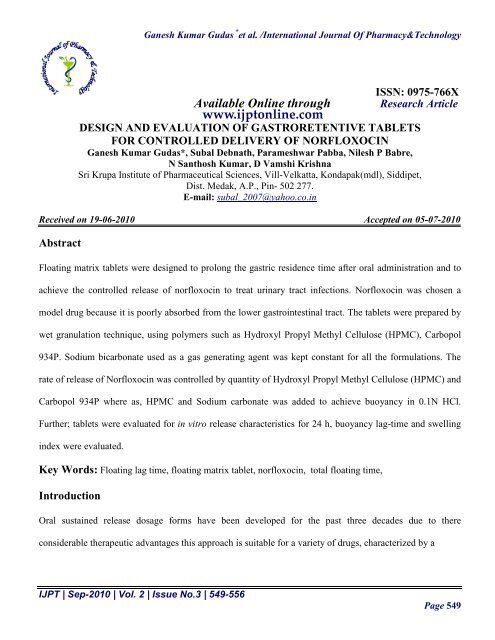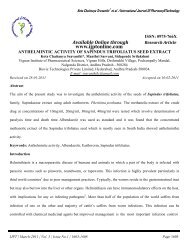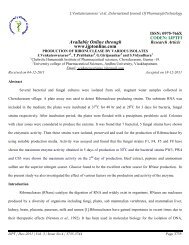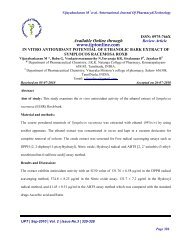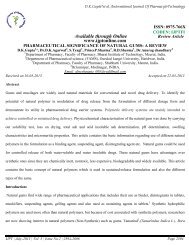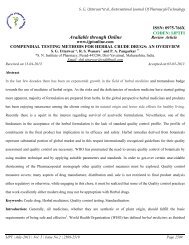Available Online through www.ijptonline.com
Available Online through www.ijptonline.com
Available Online through www.ijptonline.com
Create successful ePaper yourself
Turn your PDF publications into a flip-book with our unique Google optimized e-Paper software.
Ganesh Kumar Gudas * et al. /International Journal Of Pharmacy&Technologyweight proportion as mentioned in table 1 and <strong>com</strong>pressed on 8 station rotary tablet <strong>com</strong>pression machine(Cadmach, India ) using 8 mm standard flat face die punch set 5 .Physical Properties of floating tabletsThe prepared floating tablets were tested for weight variation, hardness and friability as per standardprocedure.Drug contentDrug content uniformity was carried out by calculating the average weight of 10 tablets and these tabletswere triturated to get a fine powder. From the resulting powder a quantity equivalent to 50 mg ofNorfloxocin was weighed and dissolved in little quantity of 0.1N HCl and volume was adjusted to 50 ml.The content of Norfloxocin was determined as per the procedure.Floating property studyThis test was performed in beaker containing 100 ml of 0.1N HCl as a testing medium maintained at 37 o C.The time required for a tablet to rise to the surface was noted to determine as floating lag time. Totalfloating time was also noted for each tablet and noted as floating time simultaneously by patel et. al. (2005).Swelling characteristicsThe swelling property of each tablet was determined by placing the individual tablet in the petridishcontaining 50 ml of 0.1N HCl .The tablets were removed periodically from petridish. After draining thewater these were measured for weight gain, thickness and diameter. The percent weight gain by the tabletwas calculated by the formula by deshpande et. al. (1997) 6 .% water uptake = Weight of the swallow tablet – Dry weight of the tablet x 100IJPT | Sep-2010 | Vol. 2 | Issue No.3 | 549-556Page 551
Ganesh Kumar Gudas * et al. /International Journal Of Pharmacy&TechnologyIn vitro release studyThe release rate of Norfloxocin from floating tablets was determined as per USP, using dissolution testingapparatus 2 (paddle method). The dissolution test was performed using 900 ml of 0.1N HCl, at 37±0.5 o Cand 50 rpm. A 2 ml of sample was withdrawn from dissolution apparatus hourly for 24h, and the sampleswere replaced with fresh dissolution medium. The samples were filtered <strong>through</strong> whatman filter paper anddiluted to a suitable concentration with 0.1N HCl. Absorbance of these solutions was measured at 278 nmusing UV/Visible double beam spectrophotometer. Duration of time, the tablet consistently float ondissolution medium were noted as total floating time 7 .Results and DiscussionThe present study was carried out to develop floating tablet of Norfloxocin in order to enhance theabsorption and bioavailability of the drug by increasing the gastric retention time in the stomach. Eightformulations (F1 to F8) were prepared by varying concentration of various formulations (Table 1).Table 1: Design of floating of Norfloxocin tablet formulations (F1-F8)Ingredients F1 F2 F3 F4 F5 F6 F7 F8Norfloxocin 400 400 400 400 400 400 400 400HPMC 110 120 130 140 110 120 130 140Carbopol 934P 15 15 15 15 25 25 25 25Sodium bicarbonate 30 30 30 30 30 30 30 30Magnesium stearate 10 10 10 10 10 10 10 10Lactose 80 70 60 50 70 60 50 40Talc 5 5 5 5 5 5 5 5Total weight (mg) 650 650 650 650 650 650 650 650IJPT | Sep-2010 | Vol. 2 | Issue No.3 | 549-556Page 552
Ganesh Kumar Gudas * et al. /International Journal Of Pharmacy&TechnologyThe shape of all formulations remained circular and no visible cracks. The percentage water uptake of allthe formulations ranges 165.65% to 190.23% formulation F7 and F8 showed a maximum % swelling indexbecause of high proportion of HPMC. This showed a higher % of water uptake. Swelling index forformulation F1 to F8 was found to be 175.45, 170.83, 182.12, 183.13, 182.06, 18436, 188.93 and 190.23%respectively. Evaluation parameters like weight variation, hardness, thickness and friability of allformulations, were found to be satisfactory and within IP limit shown in Table 2.Table 2: Evaluation of Floating tablet of NorfloxocinFormulationWeightThicknessFriabilityHardnessDrugCodevariation± S.D.± S.D.±S.D.content(g)(mm)(%)(kg/cm 2 )(%)F1 0.649±0.125 4.10±0.38 0.382±0.21 4.15±0.35 97.32F2 0.650±0.084 4.10±0.42 0.376±0.25 4.24±0.29 98.53F3 0.648±0.132 4.11±0.19 0.403±0.26 4.65±0.34 99.62F4 0.648±0.095 4.10±0.63 0.498±0.32 4.56±0.42 97.23F5 0.653±0.083 4.10±0.89 0.465±0.28 4.25±0.26 98.96F6 0.648±0.164 4.10±0.42 0.512±0.26 4.85±0.35 99.90F7 0.652±0.063 4.12±0.09 0.477±0.24 4.44±0.31 100.05F8 0.652±0.136 4.11±0.442 0.485±0.33 4.35±0.32 99.85The effect of HPMC and Carbopol 934P content on the hardness was studied. A difference in tablethardness reflects differences in tablet density and porosity, which results in different release pattern of thedrug by affecting the rate penetration of the dissolution fluid at the surface of the tablet and formation of theIJPT | Sep-2010 | Vol. 2 | Issue No.3 | 549-556Page 553
Ganesh Kumar Gudas * et al. /International Journal Of Pharmacy&Technologygel barrier. Therefore, such an effect is expected to be prominent during the initial face of the dissolutioncurve. However the results reported until now by many researchers suggest that tablet hardness has no orlittle effect on the release profile.Floating lag time studies of the tablets with different hardness between 4-5 Kg/cm 2 . It was observed thatwith increase in the hardness of the tablet the floating lag time was increased. Results of floating propertiesstudy reveal that all tablets had good floating properties are shown in Table 3. The incorporation of sodiumbicarbonate helps to improve floating properties by reacting with gastric fluid when dosage form <strong>com</strong>es incontact and produce carbon dioxide gas which entrapped inside the hydrophilic matrixes leads to increase involume of dosage form resulting in lowering of density and dosage form stars to float. Formulation F7 andF8 showed a floating lag time 1.55 and 1.42 , total floating time of 22 and 23 hrs respectively (Fig. 1(a&b))Table 3: Floating property and Swelling of formulations F1-F8FormulationFloating Lag TimeTotal Floating timeSwelling Index (%)Code(Min)(Hrs)F1 2.56±0.4 14 178.42F2 3.31±0.2 16 169.92F3 2.57±0.6 13 182.95F4 2.32±0.6 19 185.48F5 2.62±0.8 17 186.09F6 4.50±0.4 15 183.37F7 1.55±0.6 22 188.26F8 1.42±0.4 23 188.62IJPT | Sep-2010 | Vol. 2 | Issue No.3 | 549-556Page 554
Ganesh Kumar Gudas * et al. /International Journal Of Pharmacy&TechnologyFig. 1Dissolution profile of Formulation F1, F2, F3 & F4Cumulative % drug release1008060402000 2 4 6 8 10 12 14 16 18 20 22 24Time (Hrs)F1F2F3F4Cumulative % drugreleaseDissolution Profile of Formulation F5, F6, F7& F81008060402000 2 4 6 8 1012141618202224Time (Hrs)F5F6F7F8(a)(b)References1. Shrivastav A K, Wadhwa S, Ridhhurkar D. Oral sustained delivery of Atenolol from floating matrixtablet: Formulation and in vitro evaluation. INIST 2005; PP 367.2. Baumgartner S, Kristl J.; Optimization of floating matrix tablets and evaluation of their gastricresidence time. Int J Pharma; 2000; 195: PP 125-135.3. Yeole P.G, Khan S and Patel V F. Floating drug delivery system: needs and developments. Ind JPharm Sci 2005; 67(3) : PP 265-272.4. Hwang S J, Park K. Gastric retentive drug delivery systems. Crit Rev Ther Drug Carrier Syst 1998;15: PP 243-48.5. Arora S, Ali J. Ahuha A. Floating drug delivery system: a review. AAPS Pharma Sci Tech 2005; 6(3) Article 47.6. Deshpande A, Shah N, Rhodes C. Development of a novel controlled release system for gastricretention. Pharma Research 1997; 14(6): PP 815-819.IJPT | Sep-2010 | Vol. 2 | Issue No.3 | 549-556Page 555
Ganesh Kumar Gudas * et al. /International Journal Of Pharmacy&Technology7. Prajapati S T, Patel L D, Studies on formulation and In Vitro evaluation of floating matrix tablets ofdomperidone 2009; 4: PP 19-23.For Correspondence* Ganesh Kumar Gudas., M.Pharm, Asst.ProfessorSri Krupa Institute of Pharmaceutical Sciences,Vill-Velkatta, Kondapak (mdl),Siddipet, Dist. Medak, A.P., Pin- 502 277.E-mail: subal_2007@yahoo.co.inIJPT | Sep-2010 | Vol. 2 | Issue No.3 | 549-556Page 556


